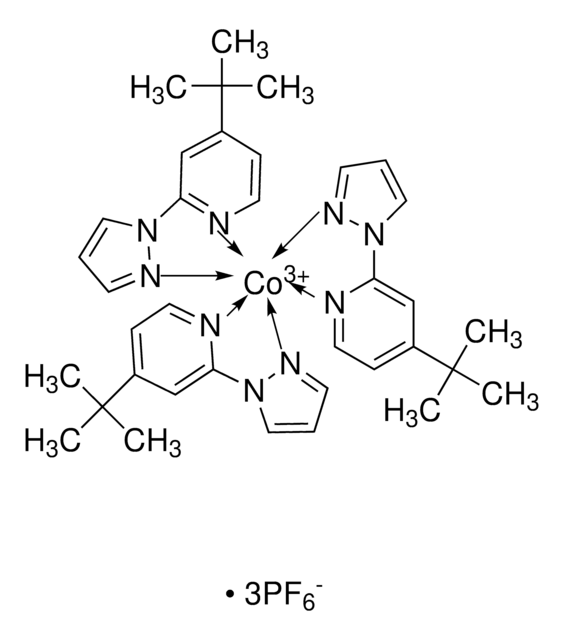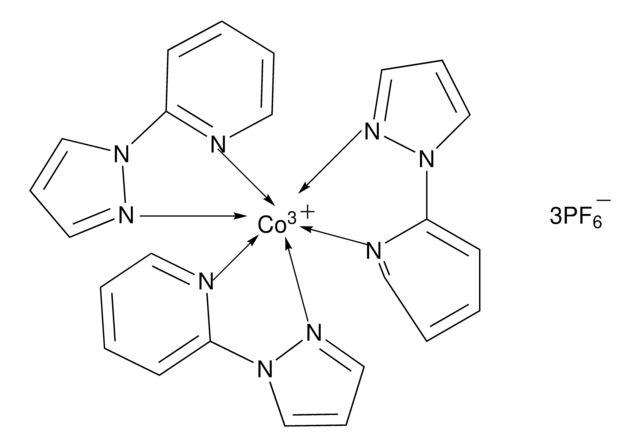805386
FK 209 Co(II) TFSI salt
Synonym(e):
Greatcell Solar®, Tris(2-(1H-pyrazol-1-yl)-4-tert-butylpyridine)cobalt(II) di[bis(trifluoromethane)sulfonimide]
About This Item
Empfohlene Produkte
Assay
98%
Qualitätsniveau
Form
powder
mp (Schmelzpunkt)
207 °C
SMILES String
O=S([N-]S(=O)(C(F)(F)F)=O)(C(F)(F)F)=O.O=S([N-]S(=O)(C(F)(F)F)=O)(C(F)(F)F)=O.CC(C)(C)C1=CC(N2N=CC=C2)=NC=C1.CC(C)(C)C3=CC=NC(N4C=CC=N4)=C3.CC(C)(C)C5=CC=NC(N6C=CC=N6)=C5.[Co+2]
InChI
1S/3C12H15N3.2C2F6NO4S2.Co/c3*1-12(2,3)10-5-7-13-11(9-10)15-8-4-6-14-15;2*3-1(4,5)14(10,11)9-15(12,13)2(6,7)8;/h3*4-9H,1-3H3;;;/q;;;2*-1;+2
InChIKey
CUSFJXUEEGOGPG-UHFFFAOYSA-N
Verwandte Kategorien
Anwendung
Rechtliche Hinweise
Signalwort
Warning
H-Sätze
Gefahreneinstufungen
Eye Irrit. 2 - Skin Irrit. 2 - Skin Sens. 1 - STOT SE 3
Zielorgane
Respiratory system
Lagerklassenschlüssel
11 - Combustible Solids
WGK
WGK 3
Flammpunkt (°F)
Not applicable
Flammpunkt (°C)
Not applicable
Analysenzertifikate (COA)
Suchen Sie nach Analysenzertifikate (COA), indem Sie die Lot-/Chargennummer des Produkts eingeben. Lot- und Chargennummern sind auf dem Produktetikett hinter den Wörtern ‘Lot’ oder ‘Batch’ (Lot oder Charge) zu finden.
Besitzen Sie dieses Produkt bereits?
In der Dokumentenbibliothek finden Sie die Dokumentation zu den Produkten, die Sie kürzlich erworben haben.
Artikel
Dye-sensitized solar cells (DSCs) are 3rd generation solar cells combining the promise of high efficiency with low production costs.
Next generation solar cells have the potential to achieve conversion efficiencies beyond the Shockley-Queisser (S-Q) limit while also significantly lowering production costs.
Dr. Perini and Professor Correa-Baena discuss the latest research and effort to obtain higher performance and stability of perovskite materials.
Research focuses on sustainable and cost-effective power generation systems to meet the growing demand for environmentally friendly energy sources.
Unser Team von Wissenschaftlern verfügt über Erfahrung in allen Forschungsbereichen einschließlich Life Science, Materialwissenschaften, chemischer Synthese, Chromatographie, Analytik und vielen mehr..
Setzen Sie sich mit dem technischen Dienst in Verbindung.




![9-Azabicyclo[3.3.1]nonan N-Oxyl 95%](/deepweb/assets/sigmaaldrich/product/structures/287/155/e2f4a2e1-1d4e-4bed-9187-9e16d23cbbbf/640/e2f4a2e1-1d4e-4bed-9187-9e16d23cbbbf.png)




